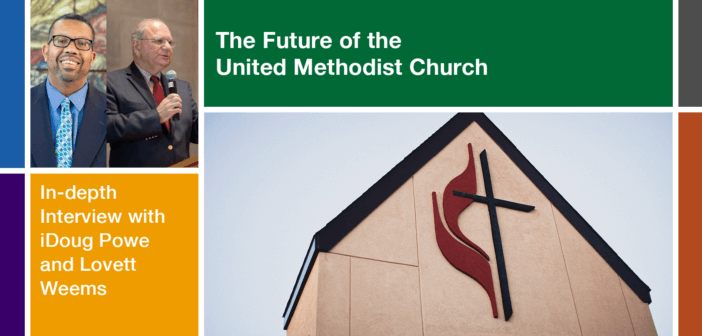What does the post-pandemic and post-disaffiliation United Methodist Church (UMC) look like? Jessica Anschutz speaks with Lewis Center Director Doug Powe and Senior Consultant Lovett Weems, who discuss the challenges and opportunities facing the United Methodist Church. They highlight regionalization, the need for structural reform, and changes to the ordination process, while advocating for renewed focus on mission. They say to remain vital, the UMC must balance sustaining traditional practices with disruptive innovation to connect with underserved communities while fostering spiritual growth and inclusivity.
Watch the interview video, listen to the interview, or continue reading.
Jessica Anschutz: Welcome to Leading Ideas Talks. Joining me are two of my colleagues, Doug Powe, the Director of the Lewis Center, and Lovett Weems, who serves as our senior consultant. Thank you, Doug and Lovett, for taking the time to speak with me today about the future of the United Methodist Church.
Doug Powe: Good to be here.
Jessica Anschutz: Doug, to start us off, what does the post pandemic, post disaffiliation United Methodist Church look like?
Doug Powe: That is a huge question. But I have a couple of thoughts. First, I want to continue to celebrate the 2024 General Conference, and the importance of it in terms of the future of the denomination. And while we’re celebrating, it’s important that, as a denomination, we remember that everything that was done will not help us to fulfill our mission if we are not intentional about it. And that includes being intentional about becoming the inclusive church that general conference envisions, remembering our history related to race and LGBTQIA+, and the trauma related to those things. So, I want to say that, while we must continue to celebrate, we also have work to do as we move forward.
Let me highlight a few things that are important for the denomination. First, we must think about creating a structure that is both stable and just for all participants in the United Methodist Church. And what I mean by that is this: I think we’re going to have to reframe the way that we do pastoral ministry. It’s going to call for a new alignment, particularly of what we have called the Board of Ordained Ministry to something more like the Board of Ministry, because we have to think of all the pathways into ministry. We’re having less ordained people go into ministry, and we need to create pathways for others—those in whom we’re seeing growth and who are engaged in congregational ministry. So, having a Board of Ministry to oversee all those pathways, I think, is going to be important.
I also think we must streamline the ordination process. The United Methodist Church has been struggling for years to get younger people involved in the process. And I think a piece of that is that the process is very long, and the process can be very convoluted. Streamlining that process, I think, is going to be important in the future.
As we think about the General Conference and regionalization, as we try to live into it and make it work in practice, it’s going to require redefining leadership roles for individuals in the conference. Regionalization is going to be important, but how are we going to redefine the leadership roles as they relate to what takes place. And finally, the world is constantly changing, and has changed; certainly, from the time when we started with a lot of family chapels and smaller congregations throughout the country, and our buildings have been a real resource, but we’re going to have to really think about the best ways to use those buildings in order to fulfill our mission as we move forward. Those are going to have to be tough and challenging conversations. Those are some of the things that we’re going to have to really think about, as we live into the sort of post-disaffiliation United Methodist Church.
Jessica Anschutz: Thank you, Doug. Lovett, does disaffiliation and changes surrounding human sexuality made at the last general conference mean that the UMC is now a “progressive” church?
Lovett Weems: Yes and no. Yes, in the sense that in most communities, the United Methodist Church is among the most progressive of the churches or in partnership with other like-minded churches would be on the cutting edge of things, and more open to new things. But I think the answer is no, if you mean that the thinking of United Methodist Church will be synonymous with an overall progressive agenda. Instead of thinking of a word like progressive, we would do better to think of a word like Methodist. That’s what we have been, and that’s what we should be.
And the Methodists have always represented an evangelical church in a liberal tradition. The reality in the United States is, to use secular terminology, we’re a purple church. And there are two main reasons we know we are a purple church. One is that we are about 90% white, and in the United States, a majority of white people have, for example, not voted for a Democrat since 1964. We also know that our churches are located disproportionately in rural counties, and those have tended to be places that have voted more conservative. What does this mean? It doesn’t mean that, the fact that we have these different views changes our hopes or dreams or aims or goals. But it does mean we have to take this into account—this additional kind of diversity, knowing that God has revealed God’s wisdom differently to different people across the church. We tend to do that more at our annual conference level and at the local church level, where we’re doing work on behalf of the church, and we have to acknowledge and be mindful of that kind of diversity. We’ve tended to do it less well at the General Conference because it seems a bit more removed from the people in the pews. So, the advances we celebrate, as those that Doug has mentioned, but we will not be a radically different church. We will be Methodists, continuing to be an evangelical church in a liberal tradition.
Jessica Anschutz: Thank you, Lovett. You’ve both hinted at some of the challenges facing the United Methodist Church in this season. So, let’s start with Doug. What are some of the specific challenges facing the United Methodist Church in the immediate future?
Doug Powe: I believe that in the immediate future, regionalization is going to be a challenge. We can begin with the fact that each annual conference is going to get a chance to debate and talk about this, and anytime you allow that to happen in a process, you’re always going to have some contention. Certainly, that will be a challenge. But I think there are some bigger questions that we need to ask about regionalization. How do we live this out practically, while remaining a truly globally connected church, is one of the questions we need to consider. Are we losing something by having nine tables instead of one big table, is another. We will need to do a lot of thinking about the long-term financial implications, as we move into this regionalization process to make sure that it remains just and fair throughout the connectional system. And I think, finally, we have to make sure we don’t let regionalization overwhelm us, so that we again lose sight of living our mission; that if we let it overwhelm us, and that becomes our focus for the next five or so years, we could really hurt ourselves in terms of the work we need to be doing in our communities to transform lives.
Let me quickly point out the other immediate challenge: Guaranteed appointment. Guaranteed appointment has been critical in terms of justice related issues, particularly for ethnic minorities and women, but I’m not sure it is sustainable any longer. Many congregations can’t afford full time pastors and live within their budget. In some conferences, they may have a surplus of clergy and other conferences, a shortage. So, the challenge is how do we maintain the justice piece of the process of guaranteed appointment, realizing we probably are going to have to move away from what we now know as guaranteed appointment in the future? I think those are a couple of the challenges that we’re going to have to deal with immediately.
Jessica Anschutz: Lovett, are there any challenges you would like to add?
Lovett Weems: If you think beyond the next year or two and think of, say, the next 10 years, we really have to get our act together. We are on a trajectory that is not sustainable. And it’s not because of the pandemic, and it’s not because of disaffiliation. It’s because of larger trends that have been going on. For instance, even before disaffiliation or the pandemic happened, say in 2019, we had 5,000 fewer churches than in 2000. The median size of attendance had gone from 53 to 38, and we had lost 42% of congregations that had 251 or more in worship, all since 2000 before the pandemic and before disaffiliation. What the pandemic and disaffiliation did was merely accelerate something that had been going on for many decades. It’s tempting to think “We’ve had the pandemic; we’ve had disaffiliation. Now, if we can get back to normal, we can get back to what it was before.” That’s not a worthy goal, because where we were before simply means we’re going back to doing our ministry in such a way each year that we continue to withdraw the United Methodist witness from the United States. And so, some major rethinking must be done about who we are, where we spend our energy, where we spend our resources, and what God is calling us to in the coming years.
Jessica Anschutz: Thank you, Lovett. As we think about what it means to be Methodist, and seek to live into being Methodist, Doug, how can Wesleyan theology guide a renewal of vitality and growth in the United States and globally?
Doug Powe: Our Wesleyan heritage is critically important. One of the things that I really appreciate about Wesley is that he was always nimble while maintaining the integrity of the theology of the Church of England. And it’s that sort of tension that, I think, is important for us today. The importance of being adaptive and connecting with people, what’s at the heart of what Wesley did and believed in. We have to make sure that we are thinking in the same way. It’s easy to get caught up in trying to copy things that Wesley did. I’ll pick one that’s a little bit more outlandish: field preaching. If we go out and preach in the fields, we’re going to attract people and all of a sudden that’s going to create vitality. It worked for Wesley in the way that he did it, and it helped people to take the next faithful step of discipleship. But field preaching is not likely to work for most of us today. What we have to consider and figure out is: how do we take what is at the heart of Wesleyan theology, that intersection of connecting with individuals, and live that out within our context in a way that we can transform lives—where we help them to draw closer to God and help them to draw closer their neighbor.
I think that the key for us is going to be being intentional about getting outside the doors of the church. So, that piece of what Wesley did is key. And, actually finding ways to be connected with our neighbor, be in conversation with our neighbors where we can help them to take that next faithful step and get to know them, so that there might be the possibility of spiritual growth. But the real key for vitality in our congregations is our willingness to be nimble, and our willingness to really connect with people like Wesley. It is not going to be simply trying to copy what Wesley did in terms of thinking about doctrine or copy what he did in terms of the practice; but it’s the way he thought and shaped theology. That is what will make a difference for us as we move forward.
Jessica Anschutz: Thank you, Doug. Lovett, Methodism has a powerful history of passion and effectiveness in sharing the gospel of Jesus Christ with others. What is needed to reclaim that heritage for our new context?
Lovett Weems: John Wesley had a passion for all humanity to come to know the love of God reflected in Jesus Christ. It was the beginning, it was the middle, it was the end of everything he did. But there were many things that flowed from that commitment to Christ, and for Wesley, it included health, prisoners, the poor, education. When Methodism came to the United States, their mission, captured in shorthand, would have been to save souls, and they did it well. Methodism went from being the smallest denomination in the country to the largest in a matter of decades. It’s the greatest example of church growth in the history of the country. But there were other things that flowed from saving souls. For example, Methodists in the United States started 1,000 schools, colleges, and universities within a 100-year period.
This is an example of where you keep your primary mission clear, and then there are so many things that emerge out of that commitment to discipleship, as Christian disciples. And as long as the church is growing, that tends to work pretty well, because people are united around the mission and there are plenty of resources, and attention, and space, for all kinds of expressions of that mission to take place.
When decline sets in, that’s when people will tend to think less about the mission and more about those expressions of the mission and values to which they feel most attached; because now, people are saying, in essence, there’s not as much as there used to be, I want to make sure that my priority is there. And so, we get caught up in debating which stanza of the song we’re going to sing the most, and then we realize we’ve all forgotten the tune. And so, we can observe our values and our commitments, but not be faithful to our mission. A community blood bank can keep confidentiality, but people could still be dying if they aren’t actually getting the blood to the community. We have to see our values, and our various commitments to ministries, as boundaries that we will honor. We will not violate the values that we are committed to; but at the same time, we know that we have to be fulfilling our mission, or simply maintaining values will not be enough.
Jessica Anschutz: Thank you, Lovett. I want to build on that and start to look toward what’s next. What kind of innovation and adaptation seems to fit congregations today in order to reach our communities. Doug, why don’t you start us off?
Doug Powe: Three aspects of innovation will be important: thinking like an outsider, taking risk, and putting aside convictions. Lovett sort of touched on these but let me add another example from a student that we actually had in our Doctor of Ministry program. This particular student, like many pastors, wanted to reach young families but realized that, in the community, what was actually needed was something that could reach mature adults. And the student was able to really work with the congregation to help them sort of put aside the conviction of “We’ve got to reach young families, we got to reach young families,” to say, “Hey, what we really need to do is be thinking about mature adults.” They took the risk of trying to reach mature adults. When he was going through this process, what he was really doing was thinking like an outsider, thinking like someone in the community outside of the church, instead of thinking insular as someone in the church. Sort of, “This is what we want to do, and we’re going to do it because that’s what we determined.” When they started, it worked out for them, and they became vital in that community because they were connecting with a community need.
So, innovation isn’t having to create something new or big that’s never been done before. It really can be very simple, really paying attention to what is happening in your context and helping your congregation to do those three things: think like an outsider, taking a risk, and putting aside your convictions.
Jessica Anschutz: Lovett, would you like to add anything?
Lovett Weems: Doug and I did a book called Sustaining While Disrupting, and I think those two dimensions capture a lot of what churches are facing. On the one hand, there’s the sustaining that’s needed, and sustaining here doesn’t mean just keep things going. It means improving, taking those things we’re currently doing, we know how to do, and lifting them to a new level. If we have a youth ministry, let’s do it better. If we have worship, let’s do it better. We have facilities, let’s improve them. So, it’s trying to do what we do – but better. But that can’t be the total effort; at the same time, we have to be doing something else. And the term “disrupting” doesn’t refer to chaos or division. Rather, it’s a technical term that tends to refer to the kind of change that reaches those previously unserved or underserved. So, at the same time that we are improving things for an established constituency, we’ve got to be taking on something that will help us enter into the world of the unserved or the underserved.
It’s like a question I would use as a pastor in Mississippi. I would say to people, “You have lived here longer than I have. All of you know this community better than I do, so I have a question for you: knowing our community as you do, tell me when we gather for worship, who’s missing.” Our churches need to be asking: who’s missing? Of the people God has given us in our communities, who are those that the way we do ministry now reaches? We celebrate that. What can we learn from that in order to reach others?
The other thing we have to do in these efforts to reach people we’ve not reached—we’ve got to build in benchmarks. We’ve got to look at outcomes. There will be failures, but we’re at a point now we can’t afford too many failures. From the beginning, we’ve got to hold ourselves accountable. Success is not a biblical concept, but fruitfulness is. And so, from the very beginning, we’ve got to monitor: “Is what we’re doing bearing the fruit we believe God has called us to bear? So that we can learn from it, change, or regroup?”
Jessica Anschutz: Thank you, Lovett. You raised the question of “Who is missing?” Most churches seem to be smaller now than they were just a few years ago. What are the special challenges that these smaller churches are facing?
Lovett Weems: We’ve always had small churches from biblical times until now; but there are more today in the United States, and they are smaller small churches than in the past. Small churches need to do what all churches do, and that is to say, “How do we take the resources we have—the people, the finances, our property—how do we take the resources we have and fulfill the mission God has given us today in the most effective ways?” The second thing they must do is ask: “How do we do this in a sustainable way? So, this ministry can continue year after year.” In order for this to happen, we need recurring expenses to be covered by recurring income. That may mean that some churches may have to rethink some of the components of their ministry, whether it’s a full-time pastor, as opposed to a shared or part-time pastor, or the kind of facility that they’re in. There may be other things like that. But the temptation is to use reserves or non-recurring funds for operating expenses in order to continue. That’s a very present-focus thing, rather than looking at the future God can still have for that congregation. Those funds are needed for capital improvements. They are needed for true emergencies, not deficits. This kind of regrouping, restructuring, rethinking the baseline is happening across many smaller churches today.
Jessica Anschutz: Doug, are there particular challenges that you would like to raise for smaller churches?
Doug Powe: One of the challenges for some smaller churches (not all) is diversity; and this is historical. Regardless of your ethnicity, many of our smaller churches were set up as family chapels, or in rural communities, where there was not a lot of diversity. The challenge is how do they not become insular, and make sure they can stay connected, given the sort of rich diversity that we’re seeing in the country, but also the rich diversity within the United Methodist Church. And some conferences are going to cooperative parishes or hubs, where churches are being connected to one another to facilitate a way for smaller churches to make sure that they can deal with diversity questions. And I think that’s going to be critically important, particularly as we think about vitality and some of the things we talked about earlier.
Jessica Anschutz: Thank you, Doug. I have enjoyed our conversation today, but I think we need to bring this to a close. So, Lovett, what have we learned from our most recent chapter of our history?
Lovett Weems: Well, I hope we’ve learned a lot because it’s been a painful chapter. I think for me, one of the most important things is for us to learn humility. That we see only dimly, and we have to stay in the conversation until more light comes. We saw dimly when we divided over slavery. We saw dimly when we practiced segregation. We saw dimly when women were not allowed as delegates to conferences. We saw dimly when women were not allowed to be clergy, but none of those things are being advocated today. Time ran out. But just because God’s wisdom is not immediately apparent to everyone does not mean that we should give up on the discernment. We need to have some humility, that we may need to spend more time seeking God’s wisdom than in trying to force our wisdom.
Jessica Anschutz: Doug, what is your hope for the United Methodist Church?
Doug Powe: Jessica, my hope is the United Methodist Church will live into the celebration and dream of the last general conference; that we would become that inclusive church that will welcome all people, and have an impact of transforming lives in our communities, where we’re making a difference, not only in terms of what is happening for people in terms of the practical daily thing, but we’re making a difference spiritually for how they are connected to God and their neighbor – which is at the heart of Wesleyan theology.
Jessica Anschutz: Thank you so much Lovett and Doug for your time today and for reflecting on the future of the United Methodist Church.
Lovett Weems: Thank you.
Doug Powe: Thank you.
Related Resources
- Innovating to Build Communities Where All Can Flourish featuring K Scarry | Watch the Leading Ideas Talks podcast video | Listen to the podcast audio version | Read the in-depth interview
- Restoring Trust in the Institutional Church Requires Allegiance to Our True Purpose by Gil Rendle
- Twenty Five Percent of Churches Disaffiliated from the United Methodist Church by Lovett Weems
Featured image by Shaun Menary on Lightstock






